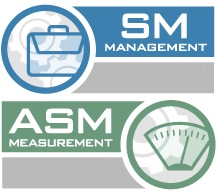SM/ASM 2002 - Software Management & Applications of Software Measurement

PRESENTATIONS
|
A Common Sense Approach to Statistical Process Control
As maturing software organizations begin using statistical process control (SPC) techniques to stabilize processes and manage quality, it's imperative that their SPC implementation approach be carefully considered, especially since it involves the use of statistical analysis techniques that are unfamiliar to most people. |
|
|
A Reliable Build-and-Deploy Process for Web Applications
While the Internet provides an array of powerful tools and utilities for developing Web applications, it also requires adequate usage management of these resources. Failing to manage usage could result in significant project setbacks, including delayed initial deployment and prolonged down time on your Web site. Bhushan Gupta discusses a process that takes build-and-deployment activity from a simple manual ritual to an on-demand, fully automated activity. He even illustrates how failures can occur and offers solutions to avoid them. |
|
|
A Short Course in Managing Expectations
Have you ever delivered exactly what your customers said they wanted, and still they were dissatisfied? This session uses a case study of one such experience as the basis for introducing information, tools, and guidelines to help you better manage expectations. Naomi Karten addresses issues such as how to build a strong foundation, avoid conflicting interpretations, implement effective feedback-gathering processes, and understand the other party's perspective. |
|
|
A Unified Model for Software Management
This is the presentation that puts all the concepts into perspective. The speaker constructs a model of the software development company as a layered organization comprised of core values at the center, then radiating out to best practices, software lifecycles, software management processes, and finally support tools and systems. Wael Amin reveals how to understand an organization's culture, identify its core values, adopt best practices, and more. His exploration runs the gamut from corporate vision to delivering quality. |
|
|
Activity-Based Cost Estimating for Web-Based Software
What does it cost to provide a feature or complete a transaction for Web-based software? In traditional activity-based cost estimating, a company looks at a product's sales activity and resources used in order to determine its cost. But how do we measure the resources used by one product, when all of the company's products share a common Web site or server? Avon Leong explores the matters involved in calculating the ongoing cost of providing online functions, and why it's important. |
|
|
Avoiding Project Failure
Let's face facts: Software projects fail more often than they succeed-and nothing a project manager does will ever completely eliminate the possibility of failure. But there are steps an organization and you as a project manager can take to detect problems early and avoid classic mistakes. This presentation is designed for project managers and sponsors who want to reduce their risk of project failure and improve their ability to successfully deliver. |

Payson Hall, Catalysis Group, Inc. |
|
Building a Learning QA Organization
As managers, we're stewards of our company's assets. Each team's capacity to learn-and rate of learning-should be treated as something to be developed, just like coding skills and other intangible corporate assets. Like many software teams, the QA team needs to be able to ramp up fast. However, due to the diversity of projects and customers, they need to know and grow even faster than most. Bill Goleman shares tricks of the learning trade and shows managers how to enhance team learning skills at little or no cost to the company. |
|
|
Communicate and Define the Value of Performance in Dollars and Cents
What is the real value of computing performance improvement? What is the real cost of computing performance degradation? This paper describes an approach used at The Boeing Company to answer these questions. The challenges of presenting technical analyses in "dollars and cents, bottom line" terminology, and sample visual formats for communicating computing performance information |
|
|
Deadlines, Defects and Risk: Managing the Three-Headed Dragon
The commercial pressures of the economy and the need for speed often impose unwieldy deadlines for software projects. Yet the nature of software projects demands that teams deal with constant change and scope growth within these fixed deadlines. By understanding software project dynamics, managers empower themselves to make better decisions about promised functionality, thereby controlling the very factors that degrade software quality and reliability. |

Michael Mah, QSM Associates, Inc. |
|
eXtreme Programming: Managing Agile Development
Extreme Programming (XP) has captured the attention of the industry by challenging many cherished beliefs held about software development and management. Not only that, it's actually delivered against those challenges. As a development process, XP focuses on producing sound software architectures while delivering required functionality to customers on time and within budget. It uses iterative development along with other controversial yet effective techniques to get the job done. |
|


